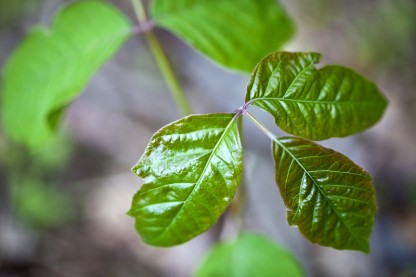Natural Remedies for Poison Ivy
 It seems like no matter how careful I am, I end up with poison ivy every year. The one benefit of all of these rashes is that I’ve have plenty of time to experiment with natural remedies for poison ivy.
It seems like no matter how careful I am, I end up with poison ivy every year. The one benefit of all of these rashes is that I’ve have plenty of time to experiment with natural remedies for poison ivy.
Poison ivy grows as either a shrub or a vine. Its leaves come in a variety of shapes, but are always in a set of three. But you can’t always see the leaves: The vines also climb trees and leave a trail of aerial roots that look hairy. The poison, an oil called uroshiol, is on leaves, stems, and roots—even after the plant dies. So the risk of developing the rash present year round.
If you are exposed
Wash it off fast. If you are exposed to poison ivy, you have about five to 15 minutes to get the oil off your skin. The American Academy of Dermatology suggests washing with lukewarm water and soap, but that has failed me on more than one occasion. I have found that wiping my skin down with alcohol after washing up has proven very effective.
Wash your clothes, shoes, doorknobs, the faucet, and absolutely anything you may have touched when you had the uroshiol on your hands. You can reinfect yourself for years—yes, years—by touching things that have traces of uroshiol. (You can not, however, spread poison ivy simply by scratching the rash or breaking the blisters. The blisters that develop several days after exposure do not contain uroshiol or any other contagious fluid.)
Once you develop a rash
If you don’t get all of the oil off and develop a rash, there are several treatments to make you more comfortable.
- Aloe vera. If you have an aloe vera plant, just break one of the leaves and use the gel inside to apply to the rash. If you don’t have a plant at home, you can buy bottled gel. (It’s great for sunburns, too!)
- Baking soda. Mix baking soda with water to make a paste. Apply to the rash and cover with gauze or bandages. Reapply as needed.
- Jewelweed is one of the top home remedies for poison ivy and it often grows in similar locations. Here’s what it looks like. Simply crush a handful and smear the juice on your rash. You can also find jewelweed soaps and creams, though my experience has been more positive with the straight plant.
- Oatmeal baths. Grab a box of oatmeal from the cupboard and prepare it so that it is thick. When cooled, apply to your skin. You can also add oatmeal to the bath for a soothing soak.
Folk remedies
People have reported positive results by applying a variety of things to a poison ivy rash. I haven’t personally tried the following yet, but they are all safe and worth a try. If you’ve tried any of these, let me know how they worked for you.
- Apple cider vinegar is said to relieve itch and help speed healing. Simply wipe on the rash with a clean cloth.
- Coffee. You can wipe black coffee on your skin, or use it as the liquid in a baking soda paste.
- Cucumber. Apply slices to the rash or mash up to make a paste.
- Dandelions. Crush dandelions and blend with honey and aloe vera juice to make a poultice.
- Turmeric is anti-inflammatory and is reported to help poison ivy heal faster. Try making a paste with lemon juice.
- Witch hazel may also proving a cooling effect that may reduce itching.
Share your experience
What are your favorite natural remedies for poison ivy? What have you found to fight the itch? What do you do to speed healing? Share you experiences in the comments section below.


 Ask the EN Experts March 2025
Ask the EN Experts March 2025  Vegan Diet Better Than Omnivore Diet for Cardiovascular Health
Vegan Diet Better Than Omnivore Diet for Cardiovascular Health 